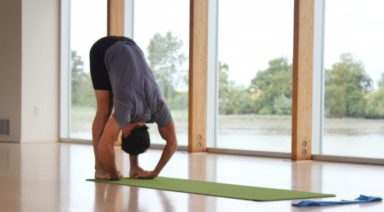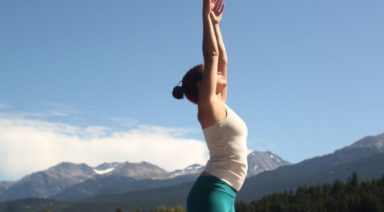Urdhva Dhanurasana: Upward-Facing Bow

Urdhva dhanurasana (OORD-vah don-your-AHS-anna) is often mis-translated as full wheel pose (chakrasana). Upward facing bow pose is a deep backbend that can cultivate flexibility, strength, and patience. This posture is worth the effort with its long list of benefits, including an energy boost and thyroid and pituitary gland stimulation.
SANSKRIT:
- Urdhva: upward
- Dhanu: bow
- Asana: pose
PHYSICAL BENEFITS:
- Expands chest, lungs, shoulders.
- Stretches hip flexors, muscles of the abdomen, wrists.
- Strengthens glutes, hamstrings, lower back muscles.
ENERGETIC BENEFITS:
- Promotes courage and compassion.
- Enlivens the chakras.
- Increases energy.
PREPARATORY POSES:
- Bridge pose | Setu bandha sarvangasana
- Reclined hero pose | Supta virasana
- Upward facing dog | Urdhva mukha svanasana
SEQUENTIAL POSES:
- One-legged upward facing bow | Eka pada urdhva dhanurasana
- Wheel pose | Chakrasana
- King dancer pose | Natarajasana
COUNTER POSES:
- Half lord of the fishes pose | Ardha matsyendrasana
- Head to knee pose | Janu sirsasana
- Reclined hand to foot pose | Supta padangusthasana
ADJUSTMENTS/MODIFICATIONS:
- Blocks on the wall: Place two blocks on the floor against a wall, about shoulder distance apart. Place your hands on the blocks as you move into urdhva dhanurasana to help elevate your upper body and better engage your shoulder blades.
- Strap: Use a strap around your upper arms to prevent the elbows from splaying as you press upward.
- Block: Place a block between your thighs to keep your lower body engaged.
- One-legged: Try out eka pada urdhva dhanurasana by lifting up one leg at a time.
STEP-BY-STEP:
- Lie on your your back with your knees bent, feet on the floor, like you’re moving toward bridge pose.
- Place your palms on the ground beside your ears, fingertips facing your shoulders.
- Press into your feet, especially the big toe ball mound.
- Exhale to lift your tailbone and hips off the floor. Squeeze your thighs toward each other so your knees point straight ahead.
- Press into your hands to bring the crown of your head to the ground. Pause here for a breath.
- Draw your shoulder blades down your back while keeping elbows in line with shoulders. Press into your feet and hands equally.
- Exhale to straighten your arms and lift your head off the floor.
- Squeeze your inner thighs toward each other and down toward your mat (internal rotation). Lengthen your tailbone toward the back of your knees.
- Drop your head all the way back if comfortable.
- Hold the pose for up to a minute with a steady, long breath. Lower down and rest, option to repeat.
###Legal Disclaimer Before participating in any exercise program or using any fitness products or services that may be described and/or made accessible in or through the Gaia Website and/or the Services, you should consult with a physician or other healthcare provider. Read more about Gaia’s Terms Of Use.
3 Ways to Cultivate and Keep a Home Yoga Practice

Starting a home practice can be a daunting task. When I talk to students about starting a home practice, the same topics keep coming up: They don’t have the space or the time, they’ve tried but can’t stick with it or when they try, they don’t end up doing the type of practice they would like to. A home practice can teach you to follow your intuition and how to listen to your body. It will teach you to make time for yourself and it will allow you to reap the benefits daily practice can bring.
Below are my top three tips for starting and keeping, a home practice:
1. Keep a journal, calendar, or both.
Why? It keeps you accountable. By writing on your calendar that you are practicing that night, you’ll motivate yourself to practice so as to avoid staring at your missed commitment the following day. A missed practice can be a big kick in the pants.
I keep my journal on a shelf in my home practice space. When I was working on incorporating consistent practice into my life, having the journal there always got me to go to my practice area, even if I had told myself I didn’t have time, or was too tired to practice. No matter what, I could always convince myself that I had time to jot down what I was feeling in my journal. After a few instances of writing but not practicing, it started to feel ridiculous to be there and not practice. One new habit fed the other.
I have both a calendar and a health journal. I check my practice off on my calendar when I’ve completed it, and I write in the journal even if I don’t do a practice. Both keep me accountable and motivated.
2. Release your expectations. All of them.
Don’t worry about having the “perfect” space to practice. Don’t worry about how much time you were able to spend on your practice on any given day, and definitely don’t worry about the kind of practice you decide to do. Find a spot that’s big enough to roll out your mat and start there. If it helps, you can set up a special space where you can keep your yoga stuff. Try setting up an alter, but don’t let an imagined need for such a space keep you from starting your practice today. All you need is one space that is big enough to lay out a yoga mat. Period.
One of the issues I faced when I was starting my home practice was making the time. It seemed like a rare occasion when I had enough time to do what I would consider to be a practice; however, once I got serious about starting a home practice, this was one of the first beliefs that I had to let go off. Some nights I come to the mat exhausted and my practice is savasana, and only savasana. Whether you practice one pose or fifty, it doesn’t matter. I don’t judge and I don’t talk down to myself as though it wasn’t enough. I don’t wish I’d done “more.” I come to the mat with the time I have and I do what works for me on that day.
This goes for the type of practice too. When I started my home practice, I had this idea in my head that my mornings would be set aside for restorative and that I would rock a vinyasa flow in the evenings. I soon learned that I had to let go of what I thought I should be doing and just do what my body told me to do. If that meant doing restorative, I did restorative. If I felt energized, I did a flow. The same rules as above apply.
Don’t judge it, and don’t think it doesn’t count just because it didn’t meet an expectation you had set out for yourself. If you do, you’ll risk getting caught up in the downward spiral of feeling like you aren’t “really” doing a home practice, and once you’re there, it’s very easy to continue with those thoughts and eventually decide that your excuses and downfalls are more powerful than your wish to practice at home. This is where a lot of us end up. Don’t give up on yourself. Persevere through these thoughts.






























